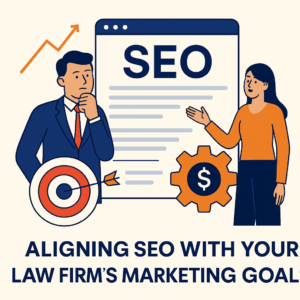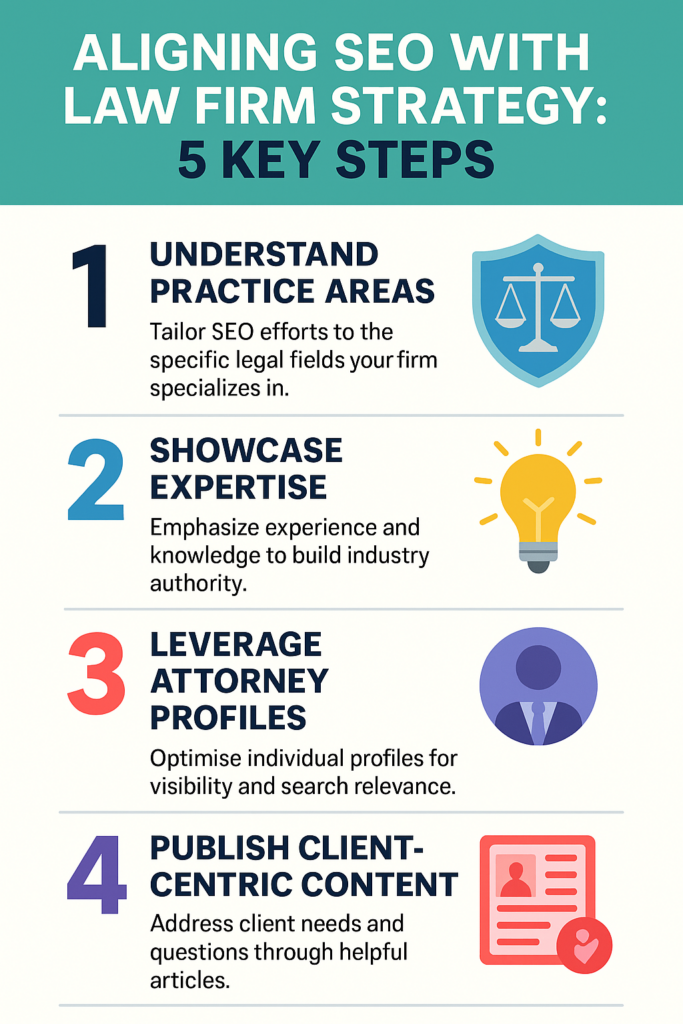What if your law firm’s SEO isn’t underperforming because of bad rankings — but because you’re optimising for the wrong goals?
Most agencies sell SEO as a technical checklist: fix the metadata, build backlinks, publish some blog posts, and wait. But in my experience working with Australian law firms at Lexora (and previously at Pulse Agency), the real wins come when SEO stops living in isolation and starts aligning with business strategy.
Why Does This Matter?
Not all traffic is good traffic.
You don’t just want more visitors. You want:
• The right cases
• In the right practice areas
• With the right client profiles
• That align with the firm’s revenue and positioning goals
Otherwise, you’re just filling the inbox with low-value leads and wearing down your team.
I’ve seen firms celebrate 300% more traffic… and 50% more headaches from unqualified leads. That’s not growth — that’s busywork.
Understanding EEAT: Experience, Expertise, Authority, Trust
Google’s been clear: legal content is Your Money or Your Life (YMYL). That means it’s held to the highest standards.
• Experience: Does the content come from someone who’s actually worked in the field?
• Expertise: Does it show depth, not just surface-level tips?
• Authority: Is the author known? Are they cited, quoted, visible?
• Trust: Is the site credible, transparent, and accurate?
For law firms, EEAT means:
• Highlighting your top practitioners — not hiding them behind a corporate “About Us”
• Surfacing case studies, media quotes, awards, speaking gigs
• Publishing thought leadership, FAQs, explainers in a human voice, not just legalese
“At Lexora, we start every SEO audit by asking: which lawyers are your biggest assets — and why aren’t they front and centre on Google?”
AEO: Answer Engine Optimisation — The Next SEO Frontier
It’s no longer just about ranking. With Google’s Search Generative Experience (SGE), voice search, and AI tools, the game is: are you the best answer?
• Are your pages structured for featured snippets?
• Are you covering topics fully, not thinly?
• Are you using schema to signal relevance?
SEO isn’t about tricking algorithms anymore. It’s about being so good they can’t ignore you.
Aligning SEO with Business Strategy
Here’s where most firms miss the mark.
They optimise for “personal injury lawyer Sydney” — because it’s a high-volume term. But they don’t stop to ask:
• Do we actually want more small injury cases, or are we shifting to class actions?
• Which practice areas drive profits, and which drain resources?
• Which partners have public profiles we can leverage for authority content?
• What differentiates us in the market, and how is that reflected in search?
Real-World Cases
Sydney Employment Law Firm
They wanted “more leads” — but the senior partner confessed most profitable cases came from executive employment disputes, not general unfair dismissal. We shifted the SEO focus to high-stakes executive matters, rewrote core pages to highlight their track record, and promoted the partner’s media commentary. Result? Fewer leads, double the revenue.
Brisbane Family Law Firm
Their site ranked for “divorce lawyer Brisbane” — but buried their expertise in cross-border custody cases. We created a content hub focused on international family law, showcased conference talks, and structured schema for AEO. They now rank as the local authority.
Tools We Recommend at Lexora
• Ahrefs or SEMrush for competitive and backlink analysis
• SurferSEO or Clearscope for content depth and semantic coverage
• Screaming Frog for technical audits
• SparkToro for audience insights — where do your clients hang out online?
• Google Business Profile and reviews management for local authority
“No tool replaces strategy — but the right stack accelerates the right moves.”
Checklist: Before You Invest in SEO, Ask Yourself
• Which practice areas do we want to grow?
• Who are our ‘star’ lawyers or rising experts?
• Do we have media mentions, awards, or recognitions we can amplify?
• How strong is our Google Business Profile and local footprint?
• What existing content is outdated, duplicated, or underleveraged?
• Are we ready to commit not just to rankings, but to being the best answer?
Common Mistakes We See (and How Lexora Fixes Them)
• SEO treated as a cost, not a growth lever → We tie SEO metrics to business outcomes — cases, not clicks
• Blind content production: “We need 10 blog posts a month!” → We audit, prune, consolidate, and go deep where it matters
• Ignoring human assets → We feature key lawyers, their stories, media presence, and cases
• Chasing keywords without strategy → We prioritise based on practice profitability, reputation goals, and competitive gaps
Conclusion: Make SEO Part of Your Business Brain
Let’s face it — SEO without strategy is vanity.
If you’re ready to align your firm’s search presence with its business ambitions, let’s have a real conversation.
At Lexora, we help law firms turn SEO into a competitive edge — one built on expertise, not just rankings.
FAQs
How does EEAT affect law firm SEO?
Google prioritises sites that show real expertise, especially for legal topics that impact people’s lives.
What is AEO, and why should law firms care?
Answer Engine Optimisation means structuring your content to become the best answer, not just the top result — critical for voice and AI search.
How do you align SEO with business goals?
Start by identifying your growth areas, your top experts, and your competitive differentiators — then build SEO strategy around those.
How can a law firm leverage its lawyers’ public footprint?
Promote media quotes, speaking gigs, publications, awards, and landmark cases — all boost EEAT and trust.
How long does it take to see SEO results?
Typically 3–6 months, but aligned strategies often show business impact fast

